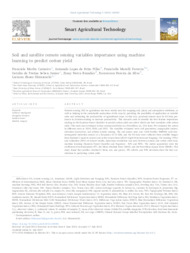Soil and satellite remote sensing variables importance using machine learning to predict cotton yield.
Soil and satellite remote sensing variables importance using machine learning to predict cotton yield.
Author(s): CARNEIRO, F. M.; BRITO FILHO, A. L. de; FERREIRA, F. M.; SEBEN JUNIOR, G. de F.; BRANDÃO, Z. N.; SILVA, R. P. da; SHIRATSUCHI, L. S.
Summary: Remote sensing (RS) in agriculture has been widely used for mapping soil, plant, and atmosphere attributes, as well as helping in the sustainable production of the crop by providing the possibility of application at variable rates and estimating the productivity of agricultural crops. In this way, proximal sensors used by RS help producers in decision-making to increase productivity. This research aims to identify the best feature importance ranking to the Random Forest Classifier to predict cotton yield and select which one best correlates with cotton yield. This work was developed in four commercial fields on a Newellton, LA, USA farm. We evaluated the cotton in different years as 2019, 2020, and 2021. The variables evaluated were: soil parameters, topographic indices, elevation derivatives, and orbital remote sensing. The soil sensor used was: GSSI Profiler EMP400 (soil electromagnetic induction sensor) at a frequency of 15 kHz, and the RS data were collected from satellite images from Sentinel 2 (passive sensor) and active sensor from LiDAR (Light Detection and Ranging). For training (70%) and validation (30%) of dataset results, Spearman correlation was used between sensors and cotton yield data, machine learning (Random Forest Classifier and Regressor - RFC and RFR). The metric parameters were the coefficient of determination (R2), the Mean Absolute Error (MAE), and the Root Mean Square Error (RMSE). This study found that profiler, Sentinel-2 (blue, red, and green), TPI, LiDAR, and RTK elevation show the best correlations to predicting cotton yield.
Publication year: 2023
Types of publication: Journal article
Unit: Embrapa Cotton
Keywords: Algodão, Artificial intelligence, Cotton, Decision trees, Estrutura do Solo, Gossypium Hirsutum, Imagem de satélite, Inteligência artificial, Produção sustentável, Proximal sensors, RS, Random forest, Remote sensing, Satellite imagery, Sensores proximais, Sensoriamento Remoto, Soil structure, Sustainable production, Árvores de decisão
Observation
Some of Embrapa's publications are published as ePub files. To read them, use or download one of the following free software options to your computer or mobile device. Android: Google Play Books; IOS: iBooks; Windows and Linux: Calibre.
Access other publications
Access the Agricultural Research Database (BDPA) to consult Embrapa's full library collection and records.
Visit Embrapa Bookstore to purchase books and other publications sold by Embrapa.

